Creative Small Bedroom Designs with Integrated Desks
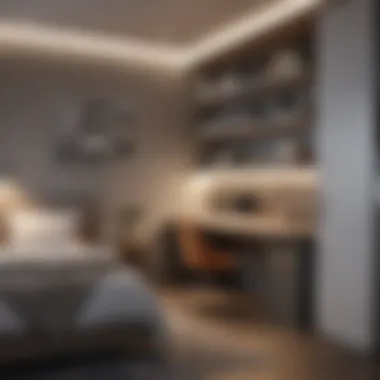
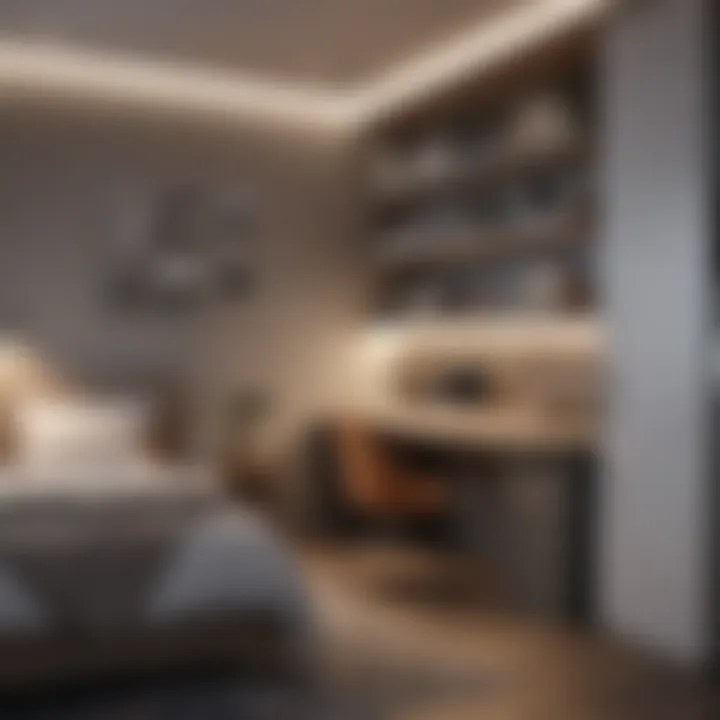
Intro
Creating a small bedroom that feels open and functional can be quite the challenge. Many homeowners find that integrating a desk—whether for work or hobbies—adds another layer of complexity. Yet, a thoughtfully designed small bedroom can provide both comfort and utility, a balance that is essential, especially in today's fast-paced world.
The key lies in understanding how to maximize every square inch without compromising your unique style. This article will explore innovative ideas and strategies, diving into design inspirations, practical solutions for desk integration, and tips to keep your space organized. Expect to find valuable suggestions that cater specifically to those operating within the confines of limited space, without sacrificing aesthetics or comfort.
Design Inspirations
When it comes to small bedrooms, inspiration can strike from a myriad of sources. Here’s a closer look at trending styles and effective color palettes that can breathe life into compact spaces while offering practical desk integrations.
Trending Styles
Embracing minimalism has become the go-to trend for many designers and homeowners alike. This style often emphasizes sleek furniture and uncluttered lines, making it perfect for small bedrooms. Furnishings with dual purpose, like a wall-mounted table that can fold away when not in use, are prime candidates for such layouts.
On the other hand, the industrial aesthetic is also gaining traction. Think raw materials, exposed beams, and metal accents. If you’re a fan of this look, a sturdy wooden desk paired with a metal chair can create a striking focal point.
Here are a few innovative ideas to consider:
- Corner Desks: Use an empty corner to keep your workspace out of the way.
- Loft Beds: Elevate your bed to create space beneath for a desk.
- Murphy Beds: Fold down your bed when needed and tuck it away when not in use, freeing up floor space.
Color Palettes
Choosing the right colors is crucial in small spaces. Light hues generally expand a room, giving an illusion of spaciousness. Soft whites, light grays, and pastels are often the first pick here. Mixing in a dark accent wall or bold accessories can add character without overcrowding the space.
For a more vibrant atmosphere, consider earth tones or muted jewel shades. A forest green accent behind the desk can create a cozy nook while maintaining an inviting ambiance.
Additionally, integrating patterned textiles can introduce visual interest while keeping the overall look cohesive. Choose items like cushions or curtains that tie together your color palette effectively.
"Even the smallest space can be transformed into a sanctuary of style and efficiency, combining the best of both worlds."
Product Recommendations
Selecting the right products can make all the difference in creating a small bedroom that is both stylish and functional. Below are some recommendations that cater to everyday needs.
Bedroom Essentials
- Multifunctional Furniture: A bed with built-in storage or an ottoman that serves as a seating and storage solution.
- Desk with Shelves: A desk that comes with shelving helps keep essential items close at hand.
Bath Accessories
- Compact Storage Solutions: Wall-mounted baskets or hooks can work wonders for bathroom space management.
- Aesthetic Organizers: Stylish containers to hold toiletries can keep your bathroom looking neat.
In crafting a small bedroom that effectively integrates a desk, the ideas and notions presented here serve not just to enhance productivity but also to nurture a spaces that feels harmonious and vibrant.
Understanding Small Bedroom Challenges
Small bedrooms can sometimes feel like trying to fit a square peg in a round hole. It can be a tough situation when you don't have ample space yet need to create a functional area that serves as both a rest haven and a workspace. The importance of understanding the challenges of small bedroom layout lies in overcoming the constraints posed by limited square footage. The right approach can significantly enhance the function and feel of these compact spaces.
Identifying Common Space Limitations
Often, the biggest hurdle with small bedrooms is the limited space for essential furniture pieces. In many homes, the bed takes up a significant portion of the room, leaving little room for a desk, chair, or storage. It can lead to a cramped atmosphere, causing frustration and stress. However, recognizing these limitations enables one to make informed decisions. For instance, place a desk strategically near a window or in a corner, maximizing both light and space.
When assessing layout, it's crucial to consider the room's dimensions. Measuring your furniture before purchasing is a sound strategy; it prevents the pitfall of overcrowding. One might also think about using smaller furniture or furniture that can serve dual purposes, like a desk that can transform into a nightstand – truly innovative solutions that work well in tight quarters.
Assessing Light and Airflow Constraints
Another significant challenge can be a lack of light and airflow. Small spaces often suffer from being dim and stuffy. This can have a profound impact on mood and productivity. A well-lit bedroom boosts creativity and motivation, especially if it includes a workspace element like a desk. When planning a layout, consider the positioning of your desk in relation to windows. Desks by the window not only benefit from natural light but also provide a refreshing breeze.
Furthermore, mirrors can work wonders in small rooms to create an illusion of more space, while also reflecting light. Try positioning a big mirror across from a window; it can brighten up even the dreariest of rooms. Ventilation is equally important. Utilizing fans or opening windows can keep the air circulating and reduce the feeling of being boxed in.
Recognizing the Need for Multi-Functional Spaces
Lastly, one cannot dismiss the importance of multi-functionality in small bedrooms. In a world where we often wish for more space, it becomes crucial to maximize the use of what we already have. Having a desk integrated into the bedroom setup shouldn’t disrupt the tranquil vibe of a resting space. Instead, it should enhance it. For example, with strategic planning, a wide desk can double as a space for lamp lighting and personal items, thus integrating workspace aesthetics into a serene atmosphere.
"A small bedroom doesn’t have to mean compromise. With smart design choices, you can achieve harmony and efficiency in your space."
Embracing the necessity of functionality can pave the way for innovative arrangements. A room that facilitates both work and rest is not just a dream; it can be a reality with the right understanding of challenges and layout optimization.
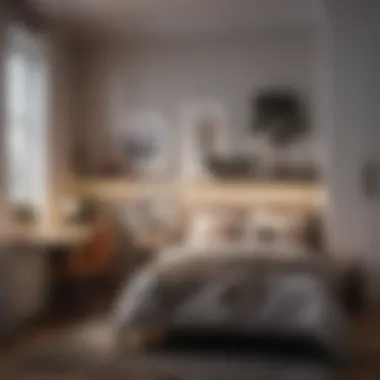
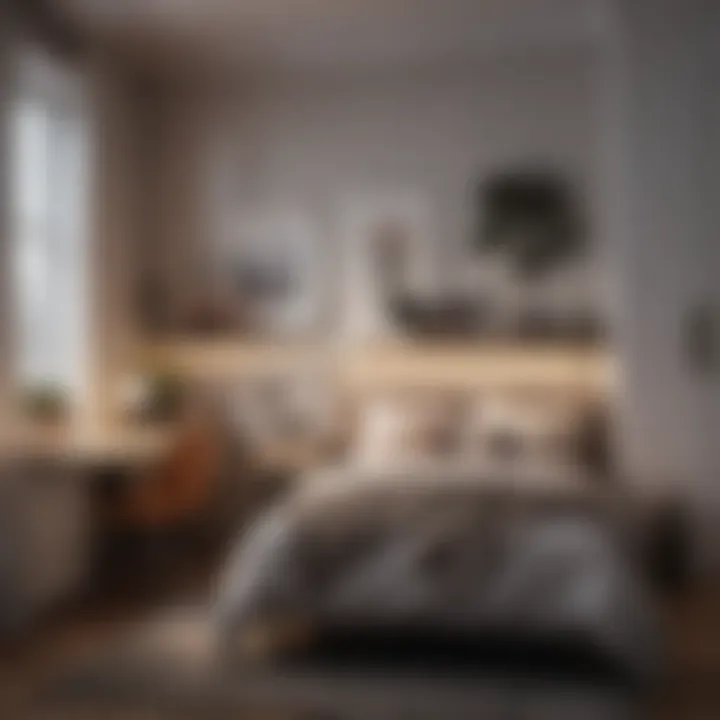
Key Considerations for Layout Planning
When working to optimize a small bedroom with a desk, thoughtful layout planning becomes crucial. Not only does this facilitate better use of space, but it also transforms the room into a harmonious blend of functionality and style. As you dive into the practicalities of arranging furniture, certain key elements come into play. These elements will ultimately govern how effectively the room serves its multi-purpose function, especially when a workspace is thrown into the mix.
Prioritizing Desk Placement for Functionality
Choosing the right spot for your desk can significantly impact how you utilize the space. When determining desk placement, consider factors like access to natural light and the overall flow of movement through the room. A corner spot might catch the morning sun, creating an energizing start to your day, while also minimizing disruption in the general layout. Whatever spot you choose, the desk should be easily accessible without obstructing pathways or creating a feeling of clutter.
Additionally, functionality speaks to keeping your desk clear and tidy. If it’s a central feature of the room, making it an eye-sore is not ideal. Use cable management solutions to keep wires out of sight, and choose organizers that help keep essential items within reach. This approach not only makes the desk more practical but also enhances the overall aesthetic of the bedroom.
Balancing Aesthetics with Practicality
A small bedroom needs to convince the eye and the mind. Spaces filled with clutter will inevitably lead to stress and distractibility, so striking a balance between style and usability is key. One trap that homeowners might fall into is sacrificing one for the other. Remember that aesthetics should complement functionality. For example, rather than just tossing any desk into the mix, consider how colors, materials, and shapes harmonize with the rest of the room.
Incorporating furniture with sleek lines or a monochromatic palette can make the space feel larger and more inviting. Centerpieces like decorative storage boxes or a stylish desk lamp can add flair while still serving an organizing purpose. Wall-mounted shelves can showcase decorative items yet retain that essential need for structure that prevents chaos from taking over.
Incorporating Storage Solutions
In a compact bedroom setting, storage solutions are essential. When space is at a premium, integrated storage helps maintain a clutter-free environment. Consider options like built-in cabinetry or multifunctional furniture. For instance, a bed frame with drawers underneath can do wonders for maintaining a tidy appearance, simultaneously freeing up floor space and allowing items to be tucked away.
Moreover, vertical storage should not be overlooked. Utilizing shelving above the desk can help keep personal items organized without consuming precious desk space. Hang organizers on walls for frequently used items, ensuring that everything has a designated place. This strategic design not only serves a practical purpose but also frees up the ambiance of the room.
"A well-organized space can significantly improve focus and creativity, especially in small bedrooms where every square foot counts."
Ultimately, planning an effective layout in a small bedroom with a desk involves meticulous attention to several key considerations. Incorporating these strategies creates a living and working area that is not just efficient, but also a reflection of personal style.
Optimizing Layout Ideas for Small Bedrooms
When it comes to small bedrooms, every inch of space counts. The aim is to develop a layout that successfully integrates a desk while ensuring the space does not feel cluttered or cramped. Optimizing layout ideas for small bedrooms emphasizes the importance of functionality, aesthetic appeal, and personal comfort in a limited area. Successful layouts can transform a small room from a mere sleep space into a multi-functional retreat where work, rest, and relaxation can coexist seamlessly.
Space optimization not only relieves frustrations related to overcrowding but also allows for personal expression. When carefully considered, arrangements can enhance both productivity and comfort. By employing innovative design concepts, one can navigate around the common challenges faced by small-room dwellers, such as a lack of natural light or limited square footage.
Corner Desk Arrangements
A corner desk arrangement is one of the cleverest ways to leverage awkward spots in a small bedroom. This setup makes optimal use of corners that traditionally house no furniture, transforming them into useful workspaces. Corner desks often come in various shapes and sizes, offering flexibility that can adapt to your room's unique dimensions. When arranged effectively, a corner desk can provide ample writing or working space while keeping the rest of the floor free for movement.
There are several benefits to consider with corner desk placements:
- Maximized Space: Utilizing a corner helps you free up the middle of the room, which can feel more open and inviting.
- Natural Light: If positioned near a window, a corner desk permits better access to daylight, which can make working more enjoyable and energizing.
- Privacy: Being slightly tucked away offers a sense of seclusion, allowing one to focus without feeling exposed.
Floating Desks: Efficient Use of Wall Space
Floating desks are an excellent choice for small bedrooms, allowing you to take advantage of wall space without consuming valuable floor real estate. Mounted to the wall, these desks offer a sleek, modern look while being highly functional. The key here is to find a balance: the desk should provide enough surface area for your needs while not overwhelming the overall aesthetic of the room.
Factors to consider for floating desks include:
- Customization: Many floating desk options allow for personalized sizing, ensuring a perfect fit in available wall space.
- Minimalist Vibe: Floating desks create an airy feel in the room, which is essential in smaller spaces where heavy furniture can make a place feel more claustrophobic.
- Easy Accessibility: Positioning the desk at an appropriate height makes it convenient for use, whether it's settling down to tackle some work or indulging in hobbies.
"A well-chosen floating desk can serve multi-functions—both as a workspace and as a surface for decoration or essential items."
Headboard-Integrated Desks
Headboard-integrated desks have emerged as a game-changer in small bedroom design. This layout seamlessly combines two essential pieces of furniture, thereby maximizing functionality without compromising personal style. By integrating the desk into the headboard, you not only save space but also create a cohesive look that ties together the bedroom's design elements.
Consider these key benefits:
- Space-Saving Design: Integrating the desk into the headboard means making efficient use of typically unused vertical space.
- Visual Appeal: A well-designed headboard desk can contribute to the overall aesthetic of the room while offering a unique focal point.
- Convenient Layout: This arrangement keeps work materials nearby but can be easily concealed, ensuring that the space remains uncluttered when not in use.
By employing one or more of these layout ideas, you can effectively create a bedroom that accommodates all your needs without feeling overwhelmed by furniture. It's all about finding that delicate balance between function and flair.
Utilizing Vertical Space Effectively
In a world where space comes at a premium, particularly in small bedrooms, utilizing vertical space is not merely a trend but a necessity. Think of vertical spaces as the hidden gems of a room—sometimes they’re overlooked, yet they hold immense potential for increasing functionality. By harnessing the vertical planes in your bedroom, you can create a workspace that is not only practical but also tailored to your personal needs and style.
When integrated properly, vertical designs can help in maintaining an open feel while optimizing the limited square footage you might be working with. This can involve a myriad of solutions, from high shelves to wall-mounted fittings that keep the clutter off your desk while providing easy access to your essentials. The benefits are many but should be approached with thoughtful planning to ensure harmony in design and function.
Vertical Storage Solutions


Vertical storage is one of the most effective ways to enhance organization without sacrificing space. Instead of relying solely on bulky furniture that spreads out horizontally, consider tall dressers or cabinets that rise upwards. For instance, having a tall, slim bookcase can serve multiple purposes—it can house your books, decorative items, and even your workspace essentials like printer and files.
- Maximize Efficiency: By pulling your storage skyward, you cut down on the need for large pieces that take up floor space.
- Accessibility: Ensure that the top shelf has items that aren’t accessed daily; a good rule is to store away seasonal items or less frequently used items in hard-to-reach places.
- Visual Interest: Using various textures and colors for your storage units can add an artistic touch to the vertical elements in your room.
Shelving Units Above Desks
Incorporating shelving units above your desk is a game-changer. They provide instant access to your most-used items while keeping your desk clutter-free. Consider these advantages:
- Easy Access: Often, we find ourselves diving into boxes and drawers to find that one notebook or a pen. Shelves right above the desk eliminate that hassle.
- Display Space: This is not just about storage; it’s also a chance to show off some decor. A mix of plants, books, and personal items can add flair and turn your workspace into a pleasant visual experience.
- Customization: Shelving can be adjusted in height and design to fit your needs, from open shelves that offer visibility to cabinets for a cleaner look.
An idea to consider is using modular shelves that can adapt as your needs change—this flexibility makes them a wise investment for your small space.
Hanging Organizers and Accessories
Accessorizing doesn’t have to mean clutter. Enter hanging organizers—these clever devices make use of vertical space and keep everything within reach. From pegboards to wall pockets, think about how these can enhance your workspace:
- Functional Decor: A pegboard can hold everything from scissors to plants, marrying functionality with aesthetics in a charming way.
- Wall Pockets: Use canvas or sturdy fabric wall pockets to neatly store items like mail, notes, or even tech accessories. They keep these necessary items at hand yet out of the way.
- Magnetic Strips: For those who love a modern twist, consider magnetic strips to hold metallic items like tools and stationery. This option is both space-saving and visually appealing.
With all these choices, it's paramount to reflect on your own habits and the kind of space that’ll best serve you. The approach toward vertical space should be a thoughtful dance involving your lifestyle needs and style preferences. By effectively utilizing vertical space, your small bedroom can transform into a harmonious, functional environment that enhances both relaxation and productivity.
"Your space is a reflection of who you are. Make it count!"
For exploration on vertical solutions: Wikipedia and Britannica.
Sharing finishes an idea rather than just storing. Why not pin your essentials on the wall? Each layer adds dimension; utilize your vertical canvas.
Creating a Calm and Productive Environment
In small bedrooms, the integration of a workspace necessitates a careful balance between comfort and functionality. A calm and productive environment isn’t just about aesthetics; it’s about fostering a space that invites focus and relaxation. To make the most of limited square footage while maintaining a tranquil aura, several specific elements and considerations need to be integrated.
This section delves into the fundamental aspects of creating such an atmosphere. When the right influences come together—whether it’s through color choices, incorporating natural elements, or managing noise levels—the space transforms from mere functionality to a nurturing environment conducive to both work and rest.
Choosing the Right Color Palette
Color plays a pivotal role in both psychological and physical spaces. For bedrooms that double as workspaces, hues should be carefully selected. Cooler shades like soft blues or greens can promote tranquility, which is essential for rest, while hints of warmer tones like mellow yellows can inspire creativity without overwhelming the senses.
Some tips for color selection include:
- Use Neutrals as a Base: White, beige, or gray provide flexibility and can expand the sense of space. They work well with accent colors, creating a balanced palette.
- Choose Calming Accents: Use colors like lavender or light blue for decor items. These can help maintain a serene ambiance while making the workspace inviting.
- Create a Cohesive Flow: Ensure that the color adjacent areas, such as the desk and bedding, complement each other. A unified appearance reduces visual chaos, crucial in small rooms.
Incorporating Natural Elements
Natural elements breathe life into a room, serving both an aesthetic purpose and potential health benefits. Plants, for example, not only enhance air quality but also contribute to mental well-being. A small potted succulent on a desk or a hanging plant can add a touch of warmth and serenity without taking much space.
Additional ideas include:
- Maximize Light with Mirrors: Strategic placement of mirrors can amplify natural light, making the space feel more open.
- Wood Elements: Incorporating wooden furniture can bring a rustic charm. Desks or shelving made from reclaimed wood can offer character while adding a natural touch.
- Nature-Inspired Decor: Art featuring landscapes or botanical themes can contribute to a calming environment, bringing the outside in and creating a sense of peace.
"Surround yourself with nature's serenity—a powerful antidote to life's chaos."
Managing Noise Levels for Concentration
Noise can be a significant distraction in small bedrooms. Managing sound levels is essential for achieving the calm necessary for productivity. Here are some effective strategies to mitigate noise:
- Soundproofing Solutions: Heavy curtains not only enhance privacy but also act as sound barriers that absorb external noise.
- Soft Furnishings: Soft rugs and cushions can reduce echoes and create a more comfortable space. A busy environment doesn't have to invade personal tranquility.
- Creating a Quiet Zone: Position the desk away from noise sources like windows facing busy streets, if possible. This thoughtful placement helps buffer distractions.
In summary, the elements of color, natural serenity, and sound control intertwine to form a balanced small bedroom that effectively integrates workspace features. Making these choices allows one's personal style to flourish while also providing a strong foundation for productivity and relaxation.
Flexible Desk Options for Small Spaces
Finding creative solutions for a small bedroom can feel like trying to fit a square peg into a round hole. But when it comes to integrating a desk into your limited space, there are plenty of options that don't require you to sacrifice comfort or style. Flexibility is the name of the game. Having a desk that adapts to your needs can transform a cramped bedroom into a functional workspace, allowing you to balance your personal life and work-life without the hassle.
Compact Desks: Form Meets Function
Compact desks are a fantastic way to marry form and function within small spaces. These desks come in various styles, but they all share one common thread: they prioritize saving space while also providing a seamless work environment. For instance, a compact L-shaped desk can snugly fit in a corner, leaving the center of your room free for movement.
Advantages of Compact Desks:
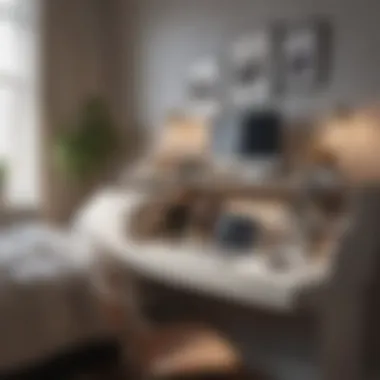
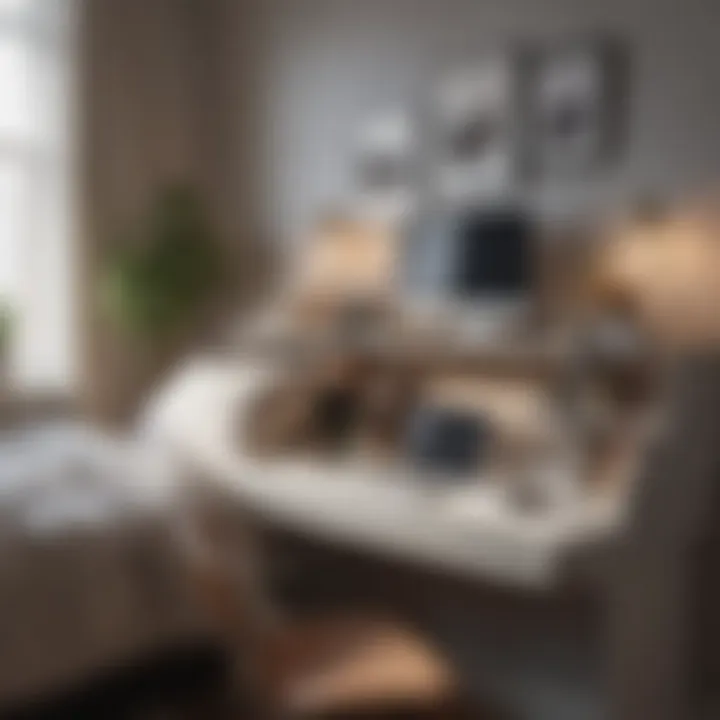
- Space Efficiency: Compact designs mean you can utilize corners or walls without feeling cramped.
- Design Versatility: Available in numerous styles from vintage to modern, you’re bound to find one that suits your taste.
- Easy Accessibility: Most compact desks are designed to be lightweight and portable, allowing you to shift them if you need a change of scenery.
A tightly designed workspace can pull double duty as a dressing area or a small reading nook, enhancing both functionality and aesthetics.
Height-Adjustable Desks for Versatility
Height-adjustable desks represent a trend that’s gained momentum in home offices, and it’s easy to see why. They allow you to alternate between sitting and standing throughout the day, which is not only beneficial for physical health but also can enhance productivity.
Benefits of Height-Adjustable Desks:
- Improved Posture: Switching between sitting and standing helps alleviate back discomfort caused by prolonged sitting.
- Boosting Energy Levels: Standing up can invigorate you during those mid-afternoon slumps,keeping your focus sharp.
- Customizable: Many of these desks can be adjusted at the touch of a button, allowing for a quick transition to your desired height without hassle.
Height-adjustable desks often come with additional features such as built-in USB ports for charging devices, making them practical and technologically savvy.
Foldable Desks: Space-Saving Solutions
When it comes to maximizing space in a small bedroom, foldable desks are truly the unsung heroes. These ingenious pieces can be extended when needed and tucked away when not in use, enabling you to reclaim your space. You can mount a foldable desk against the wall or keep a freestanding version that folds neatly.
"Foldable desks embody the perfect marriage of style and space conservation, providing utility without compromise."
Key Features of Foldable Desks:
- Easy Storage: They can be stashed away in closets or under the bed when not in use.
- Versatile Use: Pull it out for work, fold it down for leisure, and voila—you’ve got a multi-functional setup!
- Affordable: Many foldable desks are reasonably priced, making them a budget-friendly option for budget-savvy decorators.
Incorporating foldable desks into your bedroom layout encourages smart use of space while still allowing personal expression and creativity.
Incorporating Personal Style in Designs
Incorporating personal style into small bedroom layouts is more than just a matter of aesthetics; it’s about creating a space that resonates with one’s identity and meets individual needs. For anyone wrestling with the constraints of a compact setting, this becomes crucial. The choices we make in decor, from colors to textures, serve as subtle yet powerful statements of who we are. Integrating elements that reflect one’s personal touch not only enhances the visual appeal but also cultivates a sense of comfort and belonging, making the bedroom a sanctuary where one can truly unwind.
Expressing Individual Style Through Decor
When it comes to decor, personal expression takes the front seat. The introduction of colors and patterns should align with the homeowner's preferences while ensuring it blends seamlessly with the functional aspects of the space. A small bedroom may not allow for intricate designs or bold colors everywhere, but even a single statement wall—a splash of deep turquoise or a complex geometric pattern—can serve as a focal point, making the space feel uniquely yours. Here are some aspects to consider:
- Choose a Color Palette: Stick with a palette that matches your personality. Soft pastels may create a calming atmosphere, while vibrant hues can evoke energy and creativity.
- Textures Matter: Incorporating different materials, like a plush area rug or soft throw pillows, adds depth to the decor.
- Personal Mementos: Items like travel souvenirs or cherished photographs can be cleverly arranged to add an intimate touch.
Ultimately, the goal is to ensure that each element, while contributing to functionality, also narrates your story.
Art and Accessories: Customizing the Space
Art and accessories are the cherries on top when it comes to personalizing a bedroom. They have the potential to infuse character and charm while fulfilling functional roles. Seeking out artwork or accessories that resonate personally is essential. Here’s how one might enhance their space:
- Artwork Selection: Pick framed prints or original artwork that speaks to you, irrespective of current trends. If botanical illustrations are what you love, don’t overlook them.
- Functional Decor: Think about art that serves a dual purpose—like a wall clock that is visually appealing or a stylish lamp that acts as a conversation starter.
- Creative Displays: Use shelving to show off unique art pieces or an intricate plant. This not only optimizes vertical space but also turns everyday decor into a visual delight.
Not to forget, rotating accessories seasonally can keep the space feeling fresh while also reflecting your current taste.
Integrating Technology without Clutter
In our tech-driven world, owning gadgets is almost a necessity, but how do we integrate them without creating chaos? Blending technology with style in a small bedroom requires a strategic approach. Consider the following ideas to keep cords and clutter at bay:
- Cable Management Systems: Use cable clips or cord sleeves that can be affixed under the desk or along baseboards to neatly hide unattractive wires.
- Built-In Tech Solutions: Look for furniture that has inbuilt charging stations. A desk with wireless charging pads saves space and keeps surfaces clear.
- Wall-Mounted Devices: Devices like Bluetooth speakers can be wall-mounted, freeing up desk space while still providing functionality.
Balancing technology with aesthetic considerations leads to an organized and stylish bedroom that caters to modern needs.
Integrating personal style in small bedroom designs transforms mere functionality into a manageable yet stylish sanctuary for relaxation and productivity.
Epilogue: Achieving Balance in Design
In the pursuit of a stylish yet functional small bedroom, the conclusion emphasizes the remarkable synergy between design elements and usability. When a space is thoughtfully arranged, it not only enhances aesthetics but also promotes a productive environment where creativity can thrive. By addressing the multifaceted needs of various occupants, a balanced design can cater to both relaxation and work, creating a harmonious atmosphere.
Assessing Overall Functionality
To kick things off, assessing overall functionality is paramount. It involves an evaluation of how the desk integrates with everything else in the bedroom. Is it easy to access? Does it impede movement or accessibility to other areas? Consider developing a pragmatic layout that promotes seamless transitions from work to rest. For instance, positioning the desk near a window can capitalize on natural light, making it an inviting workspace. The furniture should also support your everyday activities, allowing you to utilize every square inch wisely.
Emphasizing Comfort in Small Spaces
Comfort should not be overlooked, especially in a small bedroom where each element plays a crucial role in overall well-being. A compact space can feel cramped if the furniture is not chosen wisely. Opt for ergonomic chairs and desks that encourage good posture without sacrificing coziness. Soft accents, like cushions or throws, provide a cozy feel while personalizing the space. Ensure that the bed’s setup is conducive to a restful sleep to balance the functional need for a workspace with the essential need for relaxation. Incorporating softer lighting can also greatly enhance the comfort level, transforming a stark work area into a more welcoming nook.
Final Thoughts on Small Bedroom Layouts
In wrapping up, small bedroom layouts serve as a testament to the creativity and resourcefulness of their inhabitants. Each design choice, from color schemes to desk orientation, contributes to the narrative of the space. Embrace innovative ideas—like a foldable desk or a shelving unit that doubles as a nightstand. These unique solutions bolster practicality without compromising style. Think of your small bedroom not as a limitation, but as an opportunity to craft a space that is distinctly yours and meets your needs.
"A well-balanced design can transform even the smallest of bedrooms into a sanctuary of productivity and comfort."
By considering all aspects discussed, achieving a balance in design becomes not just a possibility but a reality. With creativity and mindfulness, every small bedroom can become a true reflection of personal style and functionality.



